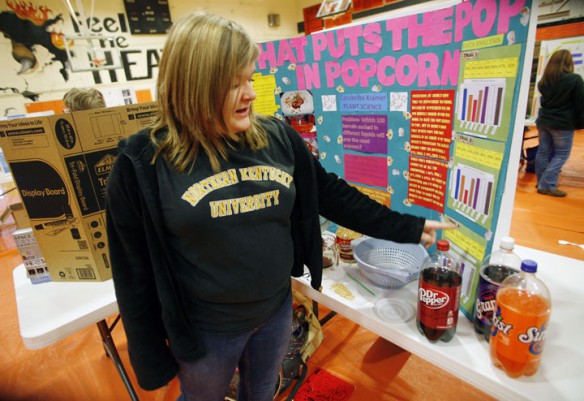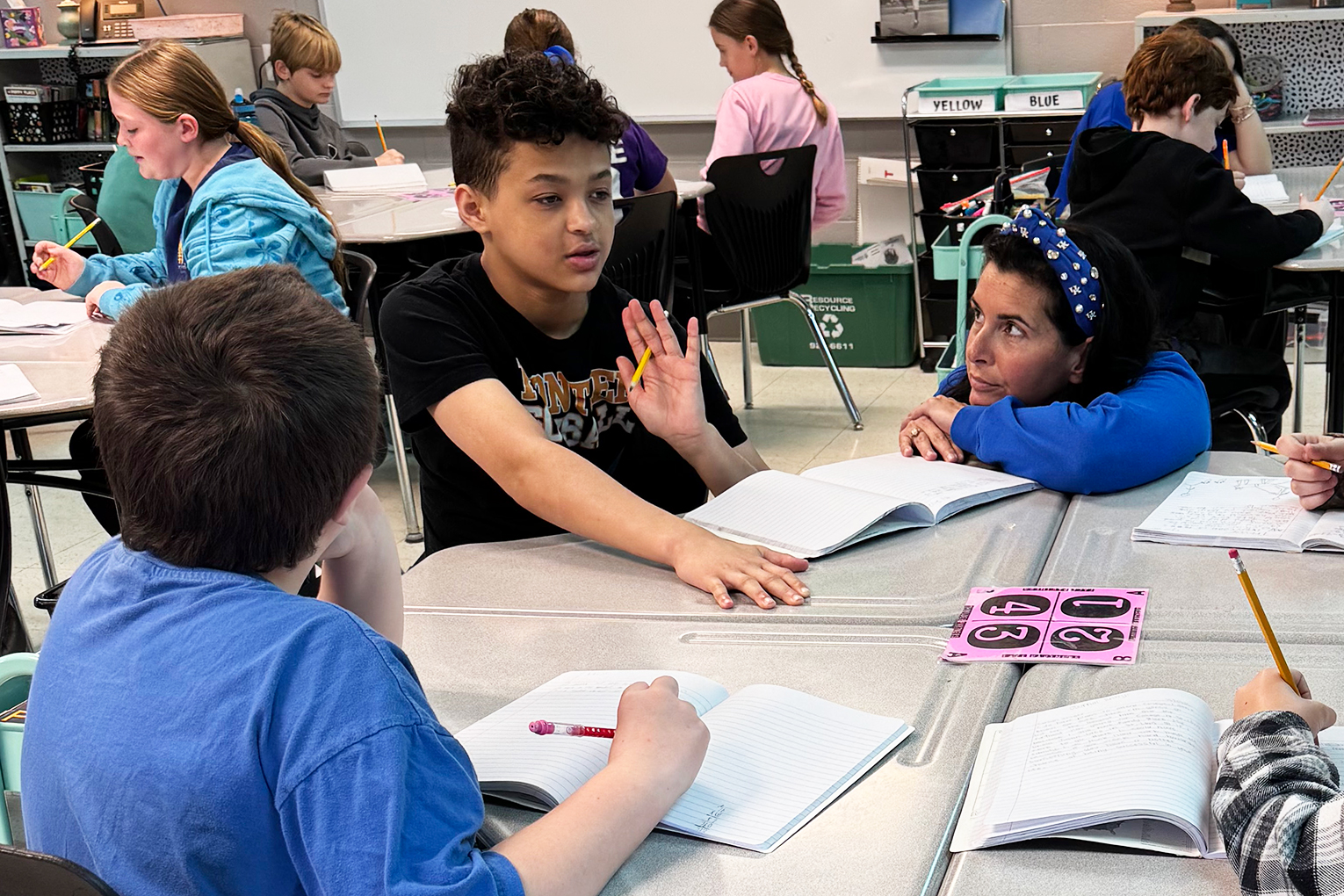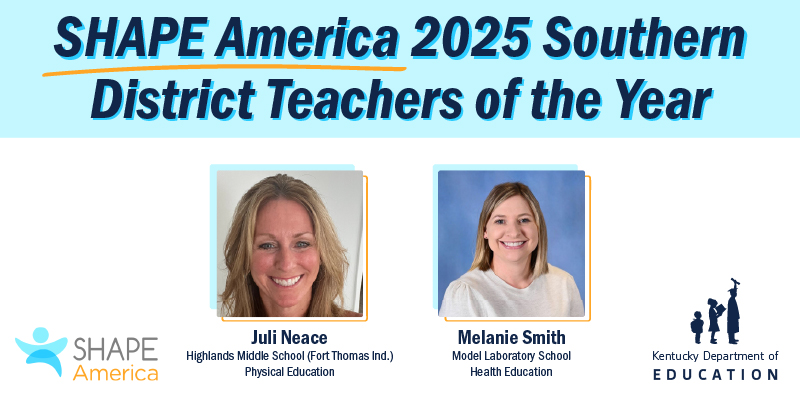
Cassandra Kramer describes her experiment that examined the impact of soaking popcorn kernels in different sodas before popping during the 8th-grade science fair at Williamstown Junior High School (Williamstown Ind.). Photo by Amy Wallot, Jan. 18, 2012
By Susan Riddell
Sean Binder, middle school science teacher at Williamstown Junior/Senior High School (Williamstown Independent), wants his students to be original, so they aren’t allowed to rely on the old standby when it comes to his school’s annual science fair.
As a result, he’s banned volcano projects for his 8th-grade science fairs.
“It seems like today when you hear the words ‘science fair,’ the first thing that comes to mind is an image of a volcano project,” said Binder, who is in his sixth year of teaching.
Instead, Binder wants his students to come up with a project that has measurable results, is creative and innovative, and has not been done over and over.
“If a student is stuck on doing a project that involves a volcano, I would encourage him or her to pick and test a single aspect of one such as volume, viscosity and volatiles. An example would be testing the pressure of different gases.”
While science fairs have been around for decades, they must stay current and innovative, teachers said.
“In the past, science fairs were more of a presentation of a topic or a poster of information with a visual and a report,” Binder said. “Today, science fair projects are more about experimentation, hypothesis, conclusions and the application of scientific method using creative ideas.”
Skip Zwanzig has been teaching science for 30 years, including the last 22 at duPont Manual High School (Jefferson County). He agreed with Binder about the shift in projects and their presentation.
“It’s not the new trends in the fairs, but rather the types of projects,” Zwanzig said. “Students quickly learn that the most successful ideas are those around ‘hot’ topics in the science world.”
Zwanzig said those hot topics include biosustainability, nanotechnology, alternative sources of energy and especially cancer research.
“What is changing about the science fair is its importance,” Zwanzig said. “People just do not realize how much a student learns by doing actual research. If a student can find a topic that he or she is really interested in, there is ownership in the project and the amount of learning by the student increases incrementally.”
Another constant of the science fair is the hope that it fosters a love of science, technology, engineering and mathematics (STEM) in students and helps them prepare for college.
“Helping students attain college and career readiness is the mission of our schools, and the STEM career fields are more important now than ever before,” said Kentucky Department of Education science consultant Sean Elkins. “Science fairs are a fantastic way to give students experiences in applied science that might be the catalyst that convinces them to pursue a STEM career.”
Science fairs also allow students to acquire and apply many of the 21st century skills needed to be successful in any career field, Elkins added. “Plus, completing a complex project gives students a sense of accomplishment and academic pride that can be a powerful motivator,” he said.
Williamstown Junior/Senior High School had its science fair last week. It’s only for 8th graders. Manual High will host its fair in March. Students in the school’s Math, Science and Technology Program are required to participate during their first three years of high school. It’s optional their senior year. Students not in the program also can participate in the science fair.
Manual’s fair is a regional science fair affiliated with the Science for Society and the Public. Zwanzig said he has to raise $15,000 to $20,000 to have a regional fair and send students to the International Science and Engineering Fair.
When assessing a student’s project, Binder has judges use a rubric that awards points for hypothesis, variables, conclusions, scientific process, design, data and overall presentation.
“I base the grade on the project by how the judge scored the project plus the written report,” Binder said.
He said popular recent projects involve students using common items in creative ways; performing experiments on items like energy drinks, candy and household cleaning products.
“I had a student who used his father’s cordless drill and built a shaking table,” Binder said. “He then built buildings out of sugar cubes and peanut butter and tested earthquakes on different building designs.”
Zwanzig said he grades the student’s research paper, not the actual research.
“Students have varied backgrounds and experiences,” he said. “There are too many different levels of research from students to compare and fairly grade, but they all know how to write a research paper. So that’s what I grade. They are all on the same level.”
Safety always is a top priority.
“Some projects will be completed with the use of tools (saws, electrical appliances) that can be dangerous,” Binder said. “I send a parent letter home which must be signed explaining the safety hazards and that they should be present when their child is experimenting.”
Both teachers say it’s a thrill seeing the projects and presentations at the culmination of the science fair. Binder said he enjoys looking at all the projects set up and admiring their creativity and experimental designs.
“The 8th-grade students have covered the scientific method for the past couple of years,” Binder added. “The science fair project is the real test to see the students apply that knowledge of the scientific method in their projects. I really enjoy seeing the projects that follow the method.”
Zwanzig said his favorite part of the school science fair is when students present their research to me in class.
“Listening to them use the language of science sends goose bumps up my spine every time,” he said.
MORE INFO …
Sean Elkins, sean.elkins@education.ky.gov, (502) 564-2106
Sean Binder, sean.bindar@williamstown.kyschools.us, (859) 824-4421
Skip Zwanzig, glenn.zwanzig@jefferson.kyschools.us, (502) 485-8241








Leave A Comment